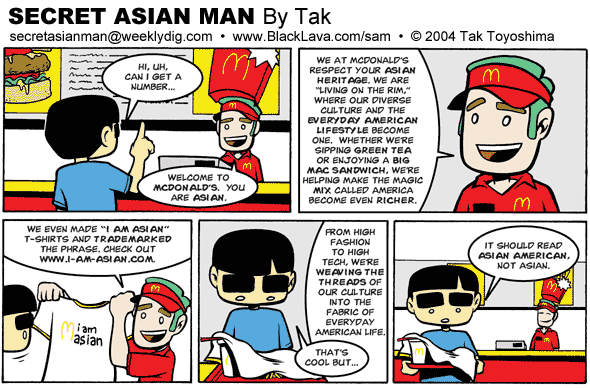
No matter the diversity of the material being written about in the reading for Tuesday (cuisine, internet, comic strips), there was a different way Asian Americans are represented in the media in each chapter.
The first representation presented was that of the way Food Network used Asian Americans for fusion cuisine shows. Both Ming Tsai and Padma Lakshmi were used as symbols of the “ethnic exotic” and “assimilated model minority.” The author of the article tells us that the idea of fusion food for these shows is to create an American or European dish using Asian ingredients, sometimes even just pouring a sauce over a dish that is considered ‘Western’. This, according to the author, problematizes the balance between the mix of Eastern and Western in the dishes, favoring the American palate rather than introducing authentic Asian food. By using these foods to fly under the radar with, it’s easier to ‘digest’ and to accept in the target audience – young and high income. Both of the shows that these two Asian Americans cooked in also portrayed them as attractive, Ming’s Quest being created after his popularity amongst his fans as being masculine and attractive. For Lakshmi it is mentioned that she uses changes in her accent and clothing to differentiate the target audiences, using revealing clothing and a ‘husky’ tone for when the subject is more sexual, like aphrodisiacs, or in a sari with a more Indian accented voice for shows about authentic Indian cooking.
Alllooksame poses the question of nationality. Is it possible to tell what nationality an Asian American is by looking at their pictures? This chapter and Secret Asian Man both use popular media, be it the internet or comic strips, to present stereotypes and, in a way, break them down. Through alllooksame, the website has you take a test to see if you can tell someone’s nationality just by looking at their picture. Even people who claimed that they could tell the three nationalities you’re tested on apart (Chinese, Korean, and Japanese), most people don’t score above 9 (half of the 18 possible points). The author also makes this point, “…this figuration of cyberculture as default white tends to demonize people of color as unsophisticated, uneducated, and stuck in a pretechnological past.” This and Tok Toyoshima poses the question of how much can non-Asian Americans claim to know about those who are Asian American. Most of what we see in popular media is full of stereotypes and tropes. Toyoshima even brings up that Asian Americans aren’t represented in talk-show panels, one of the white characters in the comic even stating, “Besides, Asians never voice their opinions so it’s OK to exclude them and mock them openly on TV!” feeding into the idea that Asians are model minorities because they quietly assimilated into American culture. When Asian Americans aren’t allowed proper representation in popular culture, how can we say what we know and see of them isn’t just a list of tropes and stereotypes?

